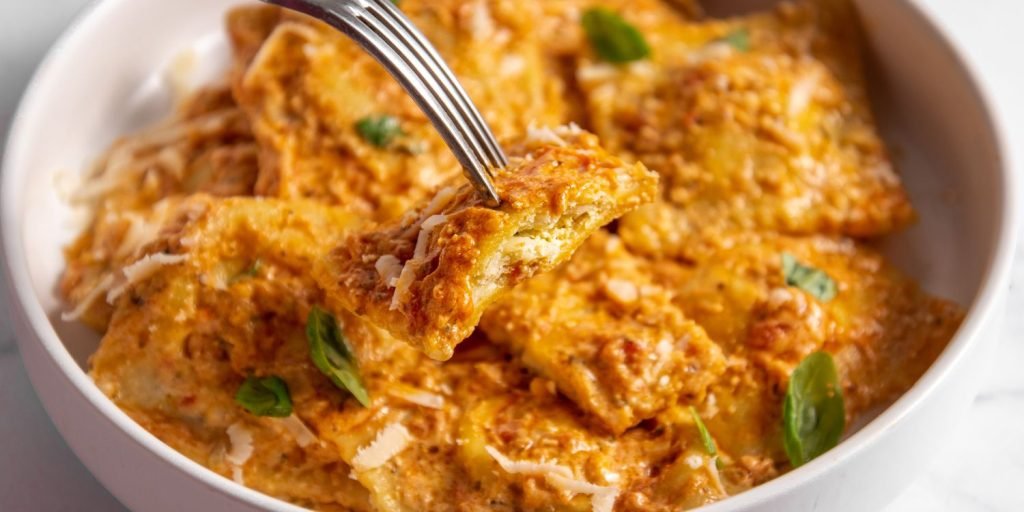Homemade ravioli is easier to make than you think! This cheesy ravioli recipe topped with a simple cream sauce is sure to impress everyone at your dinner table.
Budget Information
The total cost of this homemade cheese ravioli recipe is approximately $12.00. With about six servings, that brings the cost per serving down to just $2.00—what a steal for such a delicious dish!
Why This Recipe Works
This ravioli recipe is a delightful blend of simplicity and flavor that comes together with fresh ingredients and just a tad of culinary know-how. Making pasta from scratch can sound daunting, but it’s really just a matter of mixing, kneading, and rolling out that dough! You’ll feel like a culinary magician as you surprise friends and family with these gorgeous little pillows filled with creamy cheese — it’s comfort food at its finest!
Ingredients + Optional Substitutions
Here’s what you’ll need to whip up these delicious cheese ravioli:
- For the Dough: 2 cups all-purpose flour ($1.00), ½ teaspoon salt ($0.05), 2 large eggs ($0.50), 1 tablespoon water ($0.02), 1 tablespoon olive oil ($0.25)
- For the Filling: 1 cup ricotta cheese ($3.00), ½ cup grated Parmesan cheese ($1.50), ½ cup shredded mozzarella cheese ($1.00), ½ cup shredded provolone cheese ($1.00), 1 egg ($0.25), 1 tablespoon dried parsley ($0.10)
- For the Sauce: 2 tablespoons olive oil ($0.25), 2 cloves garlic, minced ($0.10), 1 cup prepared basil pesto ($3.00), 1 cup heavy cream ($1.50), ¼ cup grated Parmesan cheese ($0.50), 1 cup marinara sauce ($1.00)
The total price for these ingredients is about $12.00, and feel free to mix and match your cheeses to suit your taste!
Step-by-Step Recipe Instructions
Step 1: Begin by making the dough. In a large mixing bowl, pour in the flour and sprinkle the salt over it. Create a well in the center and crack in the eggs. Add the water and olive oil to the well. With a fork, gently beat the eggs and gradually incorporate the flour until a shaggy dough begins to form. Transfer the dough onto a floured surface and knead it vigorously for about 8-10 minutes until it’s smooth and elastic. Wrap it tightly in plastic wrap and let it rest in the fridge for at least 30 minutes. This is essential, as it relaxes the gluten, making it easier to roll out later!
Step 2: While the dough rests, prepare the filling. In a mixing bowl, combine the ricotta, grated Parmesan, shredded mozzarella, shredded provolone, the egg, and parsley. Stir until everything is well blended and creamy, and set aside. A taste test here is mandatory—you want to make sure it’s irresistibly delicious!
Step 3: Next, let’s get that sauce going! In a saucepan over medium heat, add the olive oil and warm it up. Toss in the minced garlic and sauté it just until fragrant—watch it carefully so it doesn’t burn! Add in the pesto and stir to combine, cooking for just a minute. Pour in the heavy cream and bring this luscious concoction to a gentle boil. Stir in the grated Parmesan, reduce to a simmer, and let it thicken slightly while you move on to the next step.
Step 4: Now, it’s time to assemble your ravioli. Roll out the dough on a floured surface to about 1/16-inch thickness. If you have a pasta roller, now’s the time to use it! Use a teaspoon or small scoop to drop mounds of filling about an inch apart along one half of the dough sheet’s length. Fold the other half of the dough over the filling and press down around each mound to seal, ensuring to remove any air pockets. Cut out individual ravioli with a knife or pasta cutter, and crimp the edges with a fork to secure the filling inside. Just look at those beauties!
Step 5: Bring a large pot of salted water to a boil, and gently add your freshly made ravioli. They’re done when they float to the top, which usually takes about 3-4 minutes. Carefully remove them with a slotted spoon and let them drain briefly.
Step 6: Serve your heavenly ravioli in bowls, drizzling the creamy pesto sauce over the top. For a beautiful presentation, finish with a little extra marinara and a sprinkle of Parmesan. Dig in and enjoy your homemade masterpiece!
Nutritional Facts
Calories: 420
Protein: 18g
Carbohydrates: 45g
Total Fats: 18g
Saturated Fat: 10g
Fiber: 2g
Sugar: 3g
Sodium: 620mg
Storage and Reheating Tips
To store your leftover ravioli, simply place them in an airtight container in the refrigerator for up to three days. When you’re ready to enjoy them again, you can easily reheat them in the microwave for a quick meal or gently warm them on the stove with a splash of extra cream or marinara sauce to keep them moist and flavorful.
Serving Suggestions
These ravioli are wonderfully filling on their own, so a light side salad dressed with lemon vinaigrette complements them perfectly. You could also pair them with some roasted vegetables or garlic bread for an extra treat. And if you’re feeling fancy, a sprinkle of fresh basil or a few toasted pine nuts on top can elevate this dish to new levels!
Reader Tips or Helpful Notes
Don’t worry if your ravioli don’t look perfectly uniform; each one is a labor of love! If you’re short on time, store-bought pasta dough can also work in a pinch. Just ensure to keep the filling creamy to make every bite a delight. Lastly, don’t forget that a tasty sauce can elevate even a simple ravioli dish, so don’t rush through that step!
Recipe FAQs
Can I freeze my homemade ravioli? Yes, absolutely! Just flash freeze them on a baking sheet and then transfer them to a freezer-safe bag for up to six months.
What type of cheese can I use for the filling? You’re welcome to mix and match! Ricotta is key for creaminess, but feel free to use mozzarella, fontina, or even substitute asiago or pecorino for extra flavor.
How do I know when the ravioli are done cooking? Fresh ravioli are done when they float to the top of the water—this usually takes about 3-4 minutes. Just keep an eye on them; overcooking can lead to a mushy texture.
What should I serve with my ravioli? A light salad, garlic bread, or roasted veggies work well. A sprinkle of fresh herbs can add that wow factor!
Can this recipe be halved? Of course! Simply adjust the ingredients accordingly to suit your needs. Pasta dough keeps well in the fridge, so you can make the full amount if you’d like and store the leftover dough for another day!


